![]()
![]()
THE CHURCH DURING THE SECOND REPUBLIC
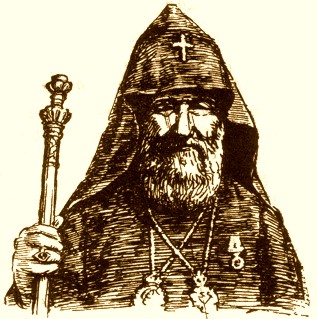
HIS HOLINESS C A T H O L I C O S G E V O R K V I
PRECEDED
THE REIGN OF HIS HOLINESS CATHOLICOS VAZGĒN I.
Written by Gevork Nazaryan
The Soviet Socialist Republic of Armenia [later renamed the Armenian Soviet Socialist Republic] -- the Second Republic -- was proclaimed by the Communist Party of Armenia on November 29, 1920. The First Republic was too weak to fight off on its own the Turkish onslaught. Mustapha Kemal "Atatürk," the dictator of Turkey launched an invasion of the Armenian Republic in September of 1920. The Allies sent no help. The Government of the Republic seeing that the European powers will not lift a finger to help out the Young Republic, accepted that Eastern Armenia should become a Soviet Socialist Republic. The XIth Red Army entered Armenia and told the Turks to immediately withdraw from Eastern Armenia or face war. During the Socialist era of Armenia, the Church, in tune with the Marxist ideology was viewed as a negative institution that at best was reactionary that stifled progress and at worst simply poisoned the minds of the masses. In addition, the Church was viewed as a rival organization that could serve as a potential deterrent for the advancement of the new revolutionary ideology -- a force which could also appeal to the superstitions of the masses. Many Monasteries and Churches were being shut down and in some cases even demolished [dynamited]. The Mother Cathedral of the Holy See in Echmiadzin was fortunately spared due to its international status and an outcry from the Armenians worldwide.
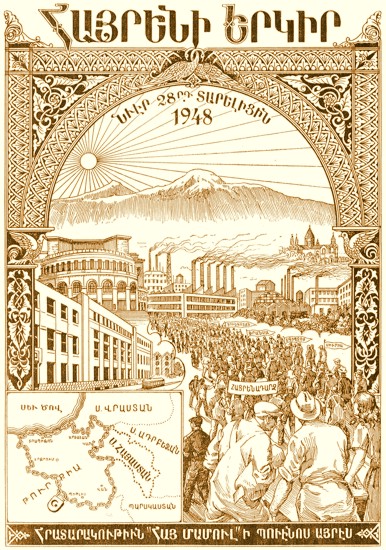
TITLE PAGE OF HOMELAND PROMOTING THE GREAT REPATRIATION
DRIVE
THAT TOOK PLACE IMMEDIATELY AFTER WORLD WAR II. HUNDREDS OF
THOUSANDS OF ARMENIANS RETURNED TO THE SACRED HOMELAND IN
ORDER TO BUILD A NEW ARMENIA.
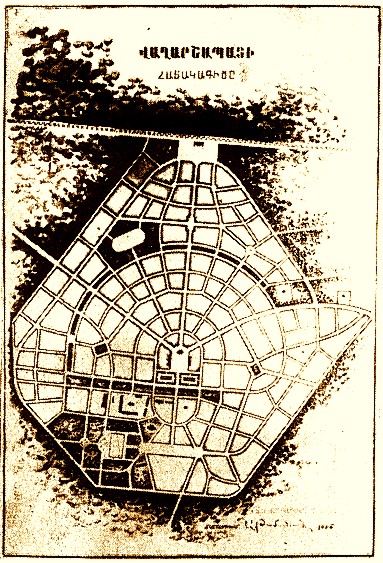
THE NEW 1925 GENERAL PLAN OF VAGHARSHAPAT BY
THE GREAT ARCHITECT ALEXANDER I. T‘AMANIAN.
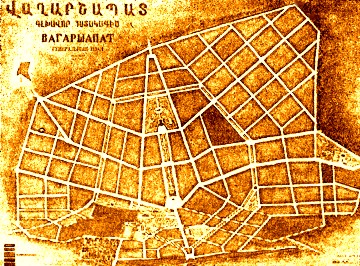
THE 1939 GENERAL PLAN OF VAGHARSHAPAT BY ARCHITECT
S. M. MANUKIAN WHO CONTINUED TO EXPAND THE AREA OF RESIDENTIAL
NEIGHBORHOODS AND CONSTRUCTION OF NEW CIVIC BUILDINGS ACCORDING
TO THE VISION SET OUT BY T‘AMANIAN.
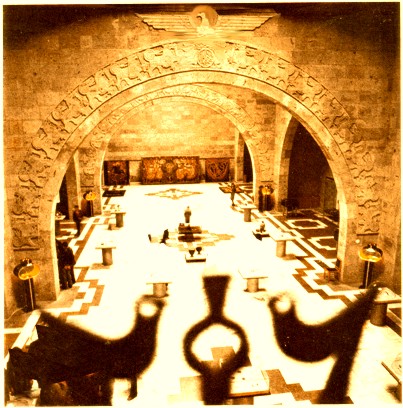
INTERIOR OF THE MAIN EXHIBITION HALL OF THE ETHNOGRAPHIC MUSEUM
OF
SARDARAPAT. THE HUGE RIBBED VAULTS ERECTED IN 1974 ADORNED WITH SACRED
ARMENIAN SYMBOLS. SOLAR RISEN EAGLE AS THE SYMBOL OF HAYR [HOR-US]
MANIFESTATION OF THE DIVINE SPARK OF THE CREATOR. ON THE CENTER/HORIZON
OF THE MASSIVE [COSMIC] ARCH.
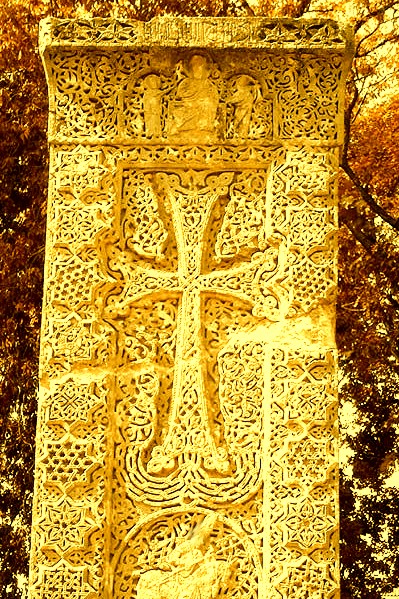
ONE OF THE ANCIENT SACRED ARMENIAN KHACHKARS PRESERVED BY THE
HOLY SEE.
STANDING ON THE PASSAGEWAY TO THE MOTHER CATHEDRAL OF ECHMIADZIN.
Perhaps one of the greatest setbacks to Armenian unity, as a result of the ideological divisions, was the separation of the Catholicosate of the Great House of Cilicia from the Mother Church and the Holy See, that took place at the height of the Cold War in 1956. The separation, was a blow to the unity of the Holy Apostolic Church and the Armenian people. Divisions among ideological and religious lines divided a people that first and foremost needed unity in order to survive and move forward. Although, the divisions of the "two Catholicosates" have to some extent lessened in the degree, nevertheless sadly they are still unresolved to this very day and serve as yet another in many respects artificial dividing line. After the collapse of the USSR, which was staunchly atheistic and whose "religion" was scientific materialism, the Church was able to once again reassert its rightful position throughout Mother Armenia.
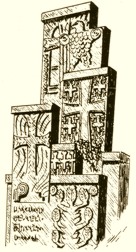
COMPOSITION OF CROSS-STONES ERECTED IN 1965 BY THE ORDERS
OF HIS HOLINESS CATHOLICOS VAZGĒN I TO
COMMEMORATE
THE 50TH YEAR OF THE GENOCIDE -- THE SOLAR EAGLE-PHOENIX IS
MARKED WITH Ē THE SACRED SEVENTH
LETTER